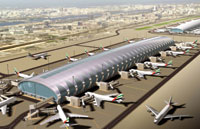
IT ranks 16th in the world in terms of international passenger movement, 14th in terms of international air freight and its rate of growth comes second only to Korea’s Incheon Airport.
Not surprising then that, according to its projections, Dubai International Airport (DIA) will have 60 million passengers by the year 2010 – currently it has a capacity to handle about 22 million passengers a year. As such, DIA’s expansion was necessary to keep up pace with its rapid growth.
“Dubai is fast emerging as the new 21st century global airline hub, thanks in large part to our visionary government, and this move will help us meet ever-rising demand for our service,” said Sheikh Ahmed bin Saeed Al Maktoum, president of Department of Civil Aviation (DCA) and chairman of Emirates Group. “With the help of the Government of Dubai, we aim to build the most advanced aviation hub, not just in the region, but in the world.”
Added Anita Mehra Homayoun, director, marketing & corporate communications, DCA: “We believe in preparing ourselves for the future and being pro-active… The airport, when the expansion works are completed by the year 2007-2008, will have the capacity to handle 70 million passengers a year.”
The Cargo Mega Terminal is part of the expansion programme that will see an eventual investment of $4.1 billion by the time the work is completed on building Terminal 3 and Concourses 2 and 3 – all of which will be exclusively dedicated to Emirates airline – to take advantage of the growing cargo movement.
However, concourses had to go through a series of redesigns to accommodate and service the soon-to-be-introduced Airbus A380 super jumbo aircraft which has pushed back the date of completion by about a year – Terminal 3 and Concourse 2 are now expected to be ready by 2007 while Concourse 3 will be finished on or before mid-2008.
The expansion programme is divided into five major elements: expansion of passenger facilities which includes Terminal 2, Terminal 3, Concourse 2 and Concourse 3; expansion of cargo facilities which includes the Mega Terminal; expansion of airfield facilities such as new aprons, taxiways, roads, tunnels and runway extension; expansion of special facilities such as VIP Pavilion, Royal Air Wing, Emirates Technical & Administration Facilities, Catering and Duty Free’s warehouses; and expansion of infrastructure and support facilities.
TERMINAL 3
Representing a radical departure in terms of its design concept when compared to the existing terminal, Terminal 3 will be located beneath the apron and taxiway area and will directly link with Concourse 2. An innovative design by Aeroports De Paris International, it will be largely invisible, much like an iceberg.
This design, in addition to being highly innovative, offers a number of distinct advantages like simplified, easy passenger flow, both inbound and outbound and reduced walking distances. The main features of the Terminal 3 building will be: a multi-level underground structure, First Class lounges and dedicated counters, restaurants, 180 check-in counters and 2,600 underground parking spaces. Even though the Departure and Arrivals halls within the terminal will be located 10 metres below the apron and taxiways, the design ensures that the passenger can maintain visual contact with the landside. What’s more, passengers will be able to access the terminal via sloped travellators so that there are no abrupt changes of level obscuring a clear view of the terminal. Other transport facilities include light trains which will link Terminal 3 to Concourse 2 and 3.
CONCOURSE 2
Dedicated exclusively for Emirates airlines, Concourse 2 will be directly connected to Terminal 3. Though it will complement the existing concourse or the Sheikh Rashid Terminal by retaining the overall tapered ‘aircraft fuselage-like’ profile, Concourse 2 will have its own distinctive architectural identity.
The main features of the building will be: multi-level structure for Departures, Arrivals and other facilities, 27 contact gates and 59 passenger loading bridges, connection to Sheikh Rashid Terminal at the Control Tower structure, 300-room hotel and health club, 10,000 sq m of commercial space which will include Dubai Duty Free and restaurants and First and Business Class lounges. One of the unique features of Concourse 2 will be five special aerobridges capable of handling the A380 super jumbo.
CONCOURSE 3
In order to accommodate larger number of the new twin-deck A380 super jumbo, the third Concourse, which will be the first dedicated terminal in the worl exclusively for the A380, has been included in the expansion programme. A scaled down version of Concourse 2 with climate controlled lounges, Concourse 3 will be connected to Concourse 2 by electric buses.
TERMINAL 2
The expansion of Terminal 2, has been planned to be conducted in two phases. After the completion first phase, which saw the construction of an interim terminal building at a cost of $3.8 million, work is now on the second phase, which will see the construction of a larger Terminal 2 at an estimated cost of $133 million. With a capacity of five million passengers, it will boast a total area of 110,000 sq m. Among other, the two-level terminal building – for departures and arrivals – will have 60 check-in counters. There will be 16 passport control desks in departures, six security screening positions, 22 boarding lounges, 22 boarding gates with aerobridges, 11 aircraft parking positions, six baggage claim carousels and 22 passport control desks in arrivals
DUBAI CARGO VILLAGE
To cope with the rapid growth in cargo movement, the airport has embarked on a $200 million phased development of a Cargo Mega Terminal, which will eventually, by the year 2018, have the capacity to handle three million tonnes of freight. The additional major cargo handling facilities will help Dubai Cargo Village to satisfy increasing demands.
